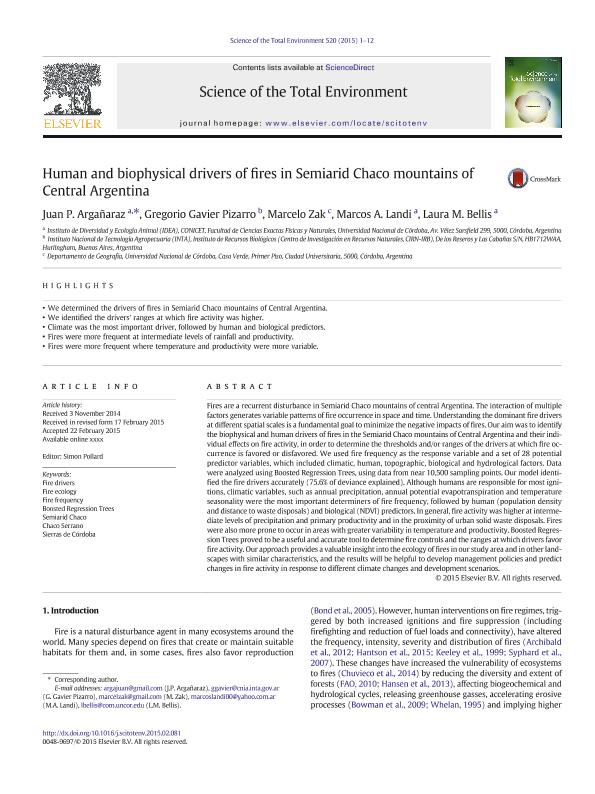Mostrar el registro sencillo del ítem
dc.contributor.author
Argañaraz, Juan Pablo

dc.contributor.author
Gavier Pizarro, Gregorio
dc.contributor.author
Zak, Marcelo Román

dc.contributor.author
Landi, Marcos Alejandro

dc.contributor.author
Bellis, Laura Marisa

dc.date.available
2016-11-02T19:10:26Z
dc.date.issued
2015-07
dc.identifier.citation
Argañaraz, Juan Pablo; Gavier Pizarro, Gregorio; Zak, Marcelo Román; Landi, Marcos Alejandro; Bellis, Laura Marisa; Human and biophysical drivers of fires in Semiarid Chaco mountains of Central Argentina; Elsevier Science; Science Of The Total Environment; 520; 7-2015; 1-12
dc.identifier.issn
0048-9697
dc.identifier.uri
http://hdl.handle.net/11336/7923
dc.description.abstract
Fires are a recurrent disturbance in Semiarid Chaco mountains of central Argentina. The interaction of multiple factors generates variable patterns offire occurrence in space and time. Understanding the dominantfire drivers at different spatial scales is a fundamental goal to minimize the negative impacts offires. Our aim was to identify the biophysical and human drivers offires in the Semiarid Chaco mountains of Central Argentina and their individual effects onfire activity, in order to determine the thresholds and/or ranges of the drivers at whichfire occurrence is favored or disfavored. We usedfire frequency as the response variable and a set of 28 potential predictor variables, which included climatic, human, topographic, biological and hydrological factors. Data were analyzed using Boosted Regression Trees, using data from near 10,500 sampling points. Our model identified thefire drivers accurately (75.6% of deviance explained). Although humans are responsible for most ignitions, climatic variables, such as annual precipitation, annual potential evapotranspiration and temperature seasonality were the most important determiners offire frequency, followed by human (population density and distance to waste disposals) and biological (NDVI) predictors. In general,fire activity was higher at intermediate levels of precipitation and primary productivity and in the proximity of urban solid waste disposals. Fires were also more prone to occur in areas with greater variability in temperature and productivity. Boosted Regression Trees proved to be a useful and accurate tool to determinefire controls and the ranges at which drivers favor fire activity. Our approach provides a valuable insight into the ecology offires in our study area and in other landscapes with similar characteristics, and the results will be helpful to develop management policies and predict changes infire activity in response to different climate changes and development scenarios.
dc.format
application/pdf
dc.language.iso
eng
dc.publisher
Elsevier Science

dc.rights
info:eu-repo/semantics/openAccess
dc.rights.uri
https://creativecommons.org/licenses/by-nc-nd/2.5/ar/
dc.subject
Fire Drivers
dc.subject
Fire Ecology
dc.subject
Fire Frequency
dc.subject
Boosted Regression Trees
dc.subject
Semiarid Chaco
dc.subject
Chaco Serrano
dc.subject
Sierras de Córdoba
dc.subject.classification
Ciencias Medioambientales

dc.subject.classification
Ciencias de la Tierra y relacionadas con el Medio Ambiente

dc.subject.classification
CIENCIAS NATURALES Y EXACTAS

dc.subject.classification
Ecología

dc.subject.classification
Ciencias Biológicas

dc.subject.classification
CIENCIAS NATURALES Y EXACTAS

dc.title
Human and biophysical drivers of fires in Semiarid Chaco mountains of Central Argentina
dc.type
info:eu-repo/semantics/article
dc.type
info:ar-repo/semantics/artículo
dc.type
info:eu-repo/semantics/publishedVersion
dc.date.updated
2016-11-02T18:14:39Z
dc.journal.volume
520
dc.journal.pagination
1-12
dc.journal.pais
Países Bajos

dc.journal.ciudad
Amsterdam
dc.description.fil
Fil: Argañaraz, Juan Pablo. Consejo Nacional de Investigaciones Cientificas y Tecnicas. Centro Cientifico Tecnologico Cordoba. Instituto de Diversidad y Ecologia Animal; Argentina
dc.description.fil
Fil: Gavier Pizarro, Gregorio. Instituto Nacional de Tecnología Agropecuaria. Centro Nacional de Investigaciones Agropecuarias. Centro de Investigación de Recursos Naturales. Instituto de Recursos Biológicos; Argentina
dc.description.fil
Fil: Zak, Marcelo Román. Universidad Nacional de Cordoba. Facultad de Cs.exactas Fisicas y Naturales. Departamento de Diversidad Biologica y Ecologica; Argentina
dc.description.fil
Fil: Landi, Marcos Alejandro. Consejo Nacional de Investigaciones Cientificas y Tecnicas. Centro Cientifico Tecnologico Cordoba. Instituto de Diversidad y Ecologia Animal; Argentina
dc.description.fil
Fil: Bellis, Laura Marisa. Consejo Nacional de Investigaciones Cientificas y Tecnicas. Centro Cientifico Tecnologico Cordoba. Instituto de Diversidad y Ecologia Animal; Argentina
dc.journal.title
Science Of The Total Environment

dc.relation.alternativeid
info:eu-repo/semantics/altIdentifier/url/http://www.sciencedirect.com/science/article/pii/S0048969715002338
dc.relation.alternativeid
info:eu-repo/semantics/altIdentifier/doi/http://dx.doi.org/10.1016/j.scitotenv.2015.02.081
Archivos asociados
